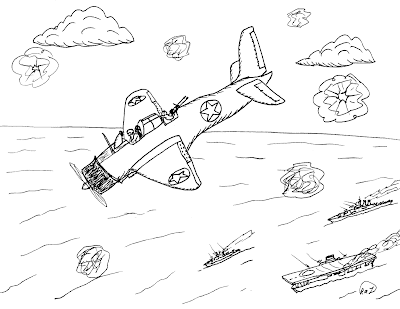Yes I know it is Sunday, and I already did a post of Jesus Calming the Sea. But today is also the 75th anniversary of the Battle of Midway. There were many brave men who gave their lives for their country that day... on June 4, 1942.
TBD Devastator Torpedo Bomber
The first planes to arrive over the Japanese attack fleet were TBD Devastator Torpedo Bombers. This plane was designed in 1934 and manufacture began in 1937 . . . and at that time it was state of the art. However, when World War II arrived the plane was obsolete. It was going up against the far more maneuverable and faster Japanese Zero Fighter.
As I wrote in a previous post...all 8 planes of the first attacking squadron of American planes were shot down and only one pilot survived. (Ensign George Gay) The other flights of TBD Devastator Torpedo Bombers also attacked and not a single torpedo hit a Japanese ship. The American gunners in the back of each bomber also did not bring down a single Japanese Zero Fighter. In all 41 American torpedo planes attacked the enemy and only 6 returned safely to their aircraft carrier. The Devastator Torpedo Bombers were not sacrificed for nothing though...because the entire cover force of Japanese Zero Fighters had dived down to shoot up the flights of attacking American planes. Because of this when the Dauntless Dive Bombers arrived next, there were no Japanese Fighter aircraft to defend their ships. Eventually all 4 Japanese aircraft carriers were destroyed by the dive bombers.
Douglas SBD Dauntless Dive Bomber
In today's Deseret News there is a report about the commander of one of those squadrons of dive bombers. Lt. Commander C. Wade McClusky led his squadron into attack and destroy one or more of the Japanese aircraft carriers. C. Wade McClusky survived the war and went on to become an admiral. His hometown of Buffalo, New York unveiled a statue of him today. Another commander of a squadron of torpedo planes, Max Leslie, lost his bomb due to faulty electric arming switches. He still led his squadron in their dive to bomb the Japanese carriers. Each Japanese aircraft carrier took 3-4 bombs. This was enough to destroy them because they were getting ready to launch another attack and their flight decks were full of fully loaded and armed planes with high octane airplane fuel in the wings. Even one hit probably would have destroyed the Japanese carriers!
Grumman F4F Wildcat Fighter Plane with Japanese Zero in Background
The main American Fighter that was used in the battle was the F4F Wildcat. A Commander Thatch developed a weave technique of flying that helped the Wildcats to outfight the faster Japanese Zero. In fact, for every F4F Wildcat shot down there were around 6 Zeros shot down. That technique is called the Thatch Weave. The Thatch weave was first used in combat at the Battle of Midway. Commander Thatch's flight of 4 F4Fs came under attack and he had his pilots and himself excecute the weave and the enemy Zeros were shot down instead of the American planes. Because the F4F was so well armed and armored, plus with good tactics like the Thatch Weave, in the early days of the war the kill ratio was 6:1. That is, 6 Japanese Zeros shot down to every 1 F4F Fighter.
I highly recommend a movie from 1976 called Midway. It tells the story of the battle and also tells the story of how, because of fear, the US imprisoned American citizens of Japanese descent. The movie also treats the Japanese sailors and flyers with respect. A famous Japanese actor played a major role as Admiral Yamamoto, the leader of the Japanese Navy at the time of the battle.
We need to remember the sacrifices of those who have died to keep our freedom. IF Japan had won the Battle of Midway it is thought that the Hawaiian Islands would have fallen next and then the West Coast of the US would have been invaded. The outcome of this battle meant that the USA would have time to mobilize its industrial might and eventually win the war. Japan was never able to mobilize another major offensive campaign during the rest of the war.



No comments:
Post a Comment